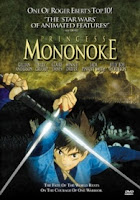Princess Mononoke (animation, adventure, fantasy)
Directed by Hayao Miyazaki
Starring the voices of Billy Crudup, Gillian Anderson, Clare Danes and Minnie Driver
Miramax | 1999 | 133 min | Rated PG-13 | Released Dec 19, 2000
The Film 4.5/5
Here’s another film from Studio Ghibli that hasn’t yet seen a Blu-ray release. If you read my recent review of My Neighbor Totoro, you’ll know that I love Miyazaki’s animation, themes and characterization. This film has a different feel to Totoro and is aimed at older audiences.
The story lasts 133 minutes and is quite violent in places. The opening scene shows a boar possessed by a demon, which is an immediate threat to a village. Ashitaka (Crudup) tackles the beast and ultimately kills it, but injures his right arm in the process. The arm is essentially possessed and the infection is expected to spread throughout his body, killing him. He’s a danger to his own people and reluctantly has to leave in search of a cure.
Like most of Miyazaki’s characters, Ashitaka is a good person. One clue to his character is the way he treats Yakul, the red elk that he rides. The two seem like partners and it’s clear that he loves the animal.
Further clues to Ashitaka’s character can be seen when he saves another village from attack and rescues two drowning men from a river. We see that his infected arm seems to have additional strength and that enemies hit by his arrows can be decapitated. As I mentioned at the outset, the film is aimed at older audiences than those targeted by Totoro. It’s bloody and violent in places and death is always a possibility.
The first magical scene takes place in a forest. The locals fear it and the tree spirits that live there, but Ashitaka has no such fears. He sees the tree spirits as happy and childlike and willingly follows their directions. They lead him and the injured men to safety. He also catches a glimpse of the Forest Spirit, which is an altogether more powerful entity and has a big role to play in the story.
Ashitaka returns the men to their town and is thanked by the town’s ruler, Lady Eboshi (Driver). She’s one of the most interesting characters in the story. She’s capable of giving people a chance where others wouldn’t and has taken in prostitutes and lepers and given them honorable roles in her town. But she’s also fiercely ambitious and thinks she’s powerful enough to kill gods to gain more wealth and power. She’s a truly divided woman, but not definitely good or evil. She does seem to genuinely want to help the people under her care and protection. Her character changes significantly by the end of the story.
Princess Mononoke has been raised by a wolf-god (Anderson) and regularly rides one of its two cubs. She hates humans because she only ever sees them harming the forest. Her character is wild and reckless and will attack the town in an attempt to stop the people causing further damage to her beloved forest. She feels that if she kills Lady Eboshi, the threat will cease to exist.
Miyazaki’s animation doesn’t look modern. It has the look of a watercolor painting and is simply drawn; but with simple drawings, he’s capable of expressing a lot of emotion. When Ashitaka looks at his elk, the animal looks friendly, loving and intelligent. Its gaze and simple expression conveys all kinds of positive feelings. The forest is also a beautiful place and you’ll find that you want to see it protected and unharmed. The tree sprites project joy and innocence and that innocence is a common theme in Miyazaki’s work. I’m not sure how he does it, but it’s powerful and moving.
The final act is full of action and a number of key characters suffer major wounds. It’s not clear who will live and who will die, but not everyone survives. Some of the animals in the story are much more than dumb beasts and many are gods capable of mutual respect when they encounter souls who deserve it. There’s a sense of that respect throughout the film and the characters live by their own honor code.
Miyazaki places us right in the middle of the action and commonly uses a panning technique as if the frames were filmed instead of drawn. He also takes his time establishing scenes and it’s common to see water ripple, grass wave in the wind or clouds move across the sky. He seems to revel in the beauty of his worlds and I find that it helps me appreciate it all the more.
The conclusion of the story feels satisfying and right. It’s not a contrived ending at all, but one which could actually happen given the personalities of the characters and their situation. It’s interesting that Miyazaki’s villains usually consist of misguided people rather than truly evil individuals. This is often the case in real life and it works better than having a stock villain like those found in most animated movies.
The actors do a good job in the English version, but the Japanese dub is included with English subtitles for anyone wishing to experience the original version.
I have only seen Princess Mononoke three times and found it a bit muddled the first time. It improved with each viewing and I now consider it just below Miyazaki’s very best work. If you thought My Neighbor Totoro and Ponyo were too childish, give this a try.
Let’s hope that a Blu-ray release isn’t too far away.
Overall score 4.5/5
See where Princess Mononoke ranks among my Top 20 animated movies.
Return to index of every review on the site.
Return to index of every review on the site.




No comments:
Post a Comment